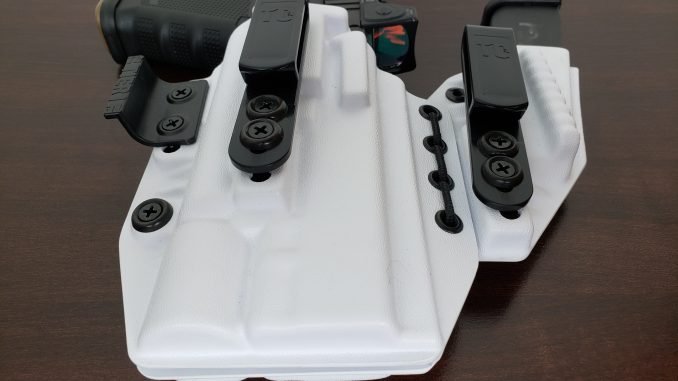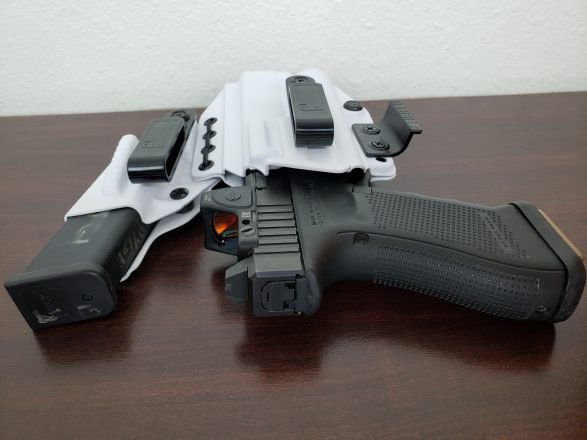
Sidecar style holsters are an immensely popular option for conceal carry. After trying two of the leading options, in T.Rex Arms and G-Code, I was left unimpressed. Fast forward a few years and a new contender rockets in popularity. This new contender is Tier 1 Concealed (T1C). Setting themselves apart from the norm, their Axis line of holsters lash the holster and magazine carrier together with cordage. The theory behind this is that the added flexibility improves concealment and comfort. Despite previous issues with sidecar holsters, I want to put my money where my mouth is. How does the Tier 1 Concealed Axis Elite stand up to the competition?
Construction and Design
The T1C Axis Elite is an appendix carry holster setup in the popular “sidecar” configuration. In short, the spare magazine carrier is physically connected to the holster itself. For a more detailed look into the type, check out Why Sidecar Style Holsters Suck. Buyers can select handedness, weapon light compatibility, a wide variety of colors for holsters and shock cord, sweat guard height, options for threaded barrels and extended magazines, and belt clip style.
Configuration
This specific model is configured for Glock 34 with a Surefire X300U and an Aimpoint ACRO. Sweat guard is mid ride, standard belt clips, with a standard capacity spare magazine, in Arctic White and black shock cord. Pricing as configured runs $134.99 as of my purchase in mid 2020 for review.

Construction is excellent, the guys at Tier 1 certainly know how to make a solid holster. Edges are clean and smooth, as are all the lines on the holster. Blocking is such that extended controls should be no issue. The mouth of the holster is slightly flared, allowing for easy re-holstering. Muzzle ends of the holster are closed.
The most stand-out feature of the Axis is its bungee cord attaching the holster and magazine carrier. This helps to improve concealment and durability compared to one-piece variants, allowing the two pieces to flex under movement, unlike traditional sidecar designs. However, this still necessitates larger holsters and magazine carriers compared to traditional setups, which reduces comfort and mobility.
Wedge and Claw
The T1C Axis comes standard with a large, screw-on claw on the gun side, and a molded-in “concealment ridge” on the magazine side, which acts similarly to a claw. The concealment ridge is an interesting design, and functions well, though there is no way to adjust its level of intensity. There is an option for a wedge from the factory, for an additional $15+, which I opted to skip.
Retention
Retention is highly adjustable for both the gun and the spare magazine. Both can be modified to nearly bucket levels of looseness or vise-like tightness. Retention stayed consistent throughout the review process despite hours of dry practice. There is no distinct “click” when the pistol is fully seated, but this is perfectly fine by me.
Mounting
Belt loops are relatively standard plastic clips emblazoned with the Tier 1 Concealed logo. Both clips are adjustable for ride height, allowing for a relatively large degree of customization. T1C also offers the Ulticlip and a special version of Discrete Carry Concepts clips for an additional charge. I opted to use the standard clips to represent what I typically see bought by others, though I’d recommend shooters use DCC clips for extra security.
Daily Use
I typically carry holster for a minimum of two weeks during the review process. Unfortunately I was not able to accomplish this with the Axis Elite due to severe discomfort. I managed roughly five, eight hour days of wear. Timeframe was May 2020.
During this time I took several 2.5 mile walks, and a few short hikes of 2-4 miles. I wore the Axis during my 1 hour commute, along with up to 9 hours at my desk during work. The first day I wore the holster for roughly 9 hours, and immediately had rubbed my stomach raw with the spare magazine. The fleshy space between the leg and groin was also raw from the bottom edge of the holster. To cut short comments about my physique, which are commonly used to discount my opinion, at the time of review I was 6’1 and 205 pounds. These are problems I’ve never experienced with standard configuration holsters and magazine carriers, even when at greater weights.
Of note, screws on the Axis Elite rusted after 48 hours of wear. I’m not sure if I got a bad batch of screws, as this has never happened with any holster I’ve previously worn.
Other Options
This is my third make of holster compatible with a Surefire X300. The other two are the PHLster Spotlight, and the Bawidamann Gotham v2. The Axis Elite is by far the most uncomfortable of the three, causing substantial discomfort within a couple hours, and pain within a few more.
Additionally, a sidecar style holster occupies more space than a traditional holster and dedicated magazine carrier. As a result, I am forced to carry fewer things along my beltline when using the T1C or other similar holsters. My Batman utility belt isn’t as robust as some, but having to find somewhere else to place my tourniquet isn’t ideal.
Final Thoughts
The Axis Elite is a very well made holster. It is certainly the best sidecar style holster I have used. However, the sidecar design is inherently flawed. If you are dead-set on carrying a sidecar style holster, despite their shortcomings, make it a Tier 1 Concealed Axis Elite. That being said, don’t carry a sidecar style holster. Instead I recommend you check out offerings from places like PHLster, Bawidamann, Dark Star Gear, Henry Holsters, Tenicor, or JM Custom Kydex.
Want to learn more about sidecar style holsters? Or need another article to tell me about why I’m fat and/or stupid? Check out this article, Why Sidecar Style Holsters Suck
Support My Work
If you made it this far, thanks for reading! Writing isn’t my full-time profession, and nearly everything I do comes out of my own pocket. Between ammunition, tuition, range fees and more, expenses add up fast. If you like what I have to offer, consider making a donation to my Patreon.
Every bit helps bring more work like this to you, and contributes to shortened timelines or more in-depth work on my part. You’ll also have more direct access to me, offering suggestions for future projects, looking behind the scenes, and getting early access to some content. You can find my Patreon >>HERE<<





When I got my axis tier1 holster and put my sig p365xl in it and wore it actually hurt. Buyer beware there is a NO RETURN POLICY.
Omg … you describe yourself as 6’ 1” 205 , but looking at the photos it looks like 60lbs are in ur beer belly … not really an optimal aiwb physique … not sure what u we’re expecting …
You complain about room on your belt for a tourniquet when caring with the tier 1 holster, um that’s one of the lamest points I’ve ever heard; I mean your not Batman and why do you need a tourniquet when you have a shirt and belt with you at all times? Also you have to pick equipment for your body habitus. You’re carrying a full size handgun and mag on your belt, even a thinner person would have trouble. What is the point of trying to conceal such a large handgun? What type of firefight could you possibly get in that requires that much ammo and not a rifle? All I’m saying is your expectations are silly and those expectations reflect in the review. You’re critiquing the equipment not on it’s deficits but your own therefore it does not give a good representation of the holster.
You’re either a troll or have a massive misunderstanding of both medical and firearms related equipment. The poor spelling and grammar make both options equally likely.
You’re far more likely to encounter a medical emergency than to need a gun. Hemorrhagic bleeding is one of the leading causes of preventable death. A tourniquet is the best way to stop this on wounds to limbs. A proper tourniquet requires a windlass, such as those in the CAT or SOFTT-W. I recommend looking at material from the TCCC, Stop the Bleed, Dark Angel Medical, or Lone Star Medics for more information.
We want to carry as much gun as possible within our ability to conceal. A larger gun is easier to shoot so long as it fits our hands. This is easily shown by comparing scores with full size and subcompact pistols on standardized courses of fire. Better shooting characteristics mean better shot accountability to stop the threat sooner and reduce the likelihood of unintentionally striking bystanders.
Looking at crime statistics over the past decade shows that roughly 50% of violent encounters feature multiple attackers. Looking at data from shootings, it takes approximately 3-5 rounds from a pistol to stop a threat. This means that we have a significant likelihood of needing at least 6-10 rounds to solve a violent encounter, with an additional 3-5 rounds for every additional threat. This does not take into account returning threats, which is not uncommon, where we restart the process. As we can see, capacity rapidly becomes a concern for our chosen defensive handgun. The spare magazine helps us here, and is also useful in the event of a stoppage or malfunction, which happen far more regularly in defensive encounters than on the square range. We can’t predict what events may find us, so we must prepare for the worst, within certain limitations.
The extension on the spare magazine is less about additional capacity and more for increasing our ability to access the magazine, as well as improving comfort thanks to its rounded edges compared to the hard angles of the factory magazine.
The rifle comment is irrelevant because we don’t carry long guns as normal civilians.
Sidecar style holsters fail where standard holsters succeed. They work for a more limited portion of the population, and even then they work in a reduced capacity.
What experience are you basing your opinions on?